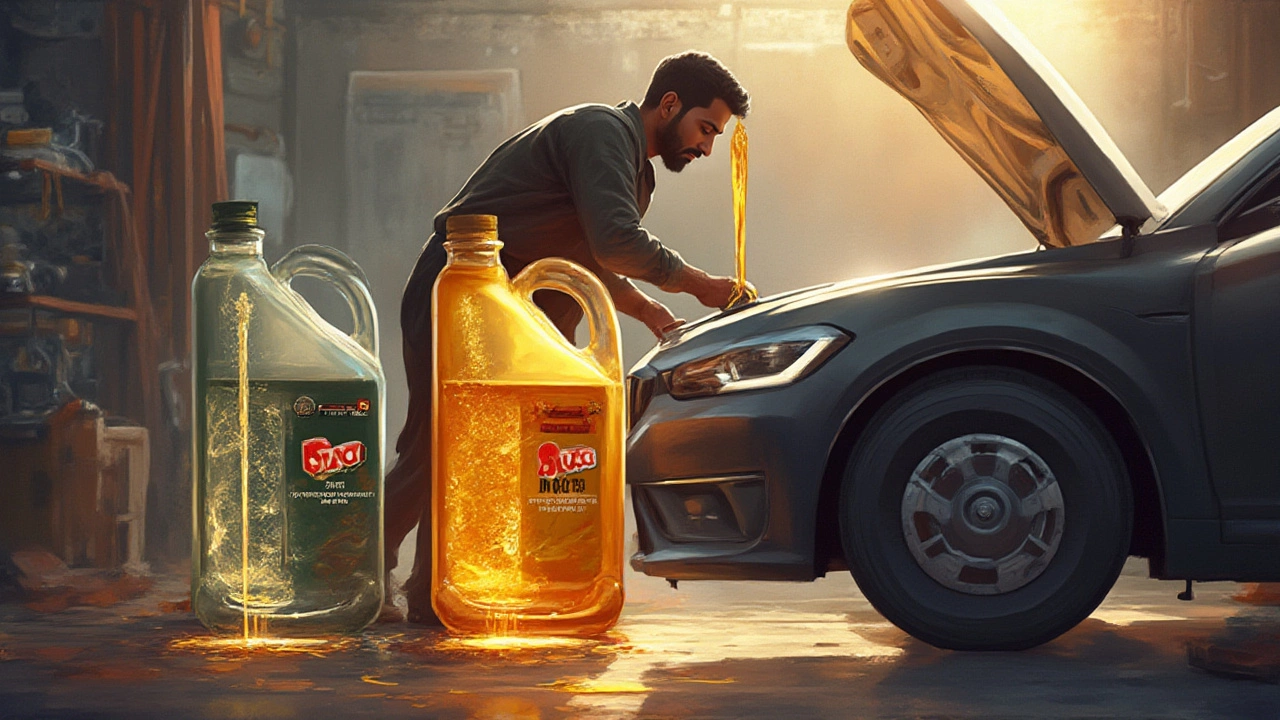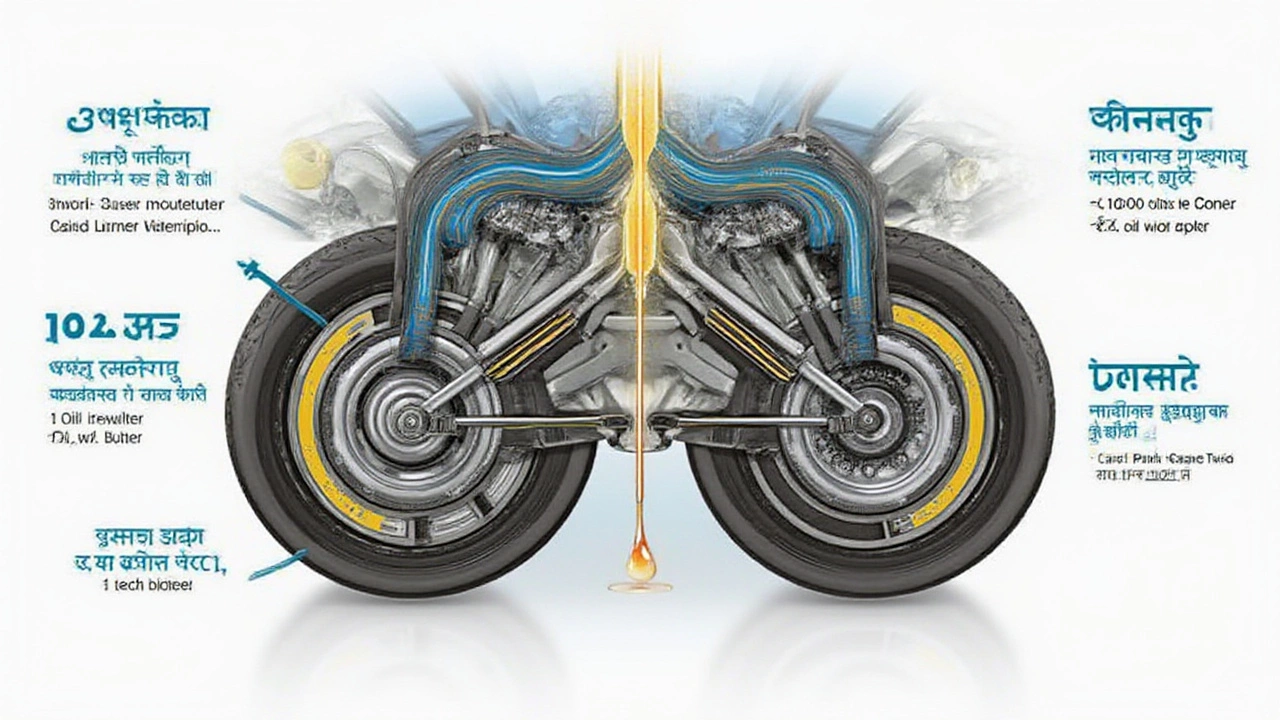 Jul, 17 2025
Jul, 17 2025
If you’ve ever stared at an oil shelf, brows furrowed at all those numbers and letters, you’re not alone. Picture this: you’re due for an oil change, you reach for the familiar 5w30 your manual recommends, but the store only has 10w30 left in stock. Is your engine doomed if you pour it in? Or will your car brush it off like it’s no big deal? This isn’t just about numbers on a bottle—it’s about the vital fluid your engine relies on every time you drive. Messing with that recipe can have real, engine-altering consequences. Let’s break down what really happens inside your car if you swap one for the other.
Understanding Oil Viscosity and Why It Matters
Let’s start simple. Those numbers on your oil bottle—5w30, 10w30—aren’t just for show. They’re a code for how your oil behaves under different temperatures. The first number (the “5” or “10”) refers to how thick or runny your oil is at cold temperatures. The “w” stands for winter, not weight. Lower numbers mean the oil is thinner when your engine is cold, so it can flow faster on chilly mornings.
The second number (the “30”) shows how thick the oil stays at a high operating temperature. Both 5w30 and 10w30 will be about the same thickness when your engine’s nice and hot. The only real difference is how they flow when you first start up. Think of honey and syrup in the fridge: one pours slightly quicker than the other until they warm up on a pancake. Your car’s engine is a bit like that but with way higher stakes, because poor oil flow at start-up can mean metal grinding metal before things heat up.
Why does this matter? Because modern engines are built with tight tolerances—tiny gaps between moving parts that need fast oil flow to avoid wear. If the oil is too thick at start-up, it takes longer to lubricate those sensitive areas. That’s especially true if you live somewhere cold, where engines are slow to warm up. A test by the American Petroleum Institute shows that using higher viscosity oil (like swapping 5w30 for 10w30) at low temperatures can increase start-up wear by as much as 30% if your car’s designed for thinner oil.
Of course, both 5w30 and 10w30 are considered multi-grade oils, so each can adapt somewhat to hot and cold. But, just because it can adapt doesn’t mean it’s perfect. Cars today aren’t as forgiving as those old-school engines from the ‘80s or ‘90s. If you look at your manual, there’s usually a chart showing which oil is right for which temperature range. There’s a reason those charts exist—they’re based on real-world engine tests, not guesses.
Take, for instance, a common sedan like a 2018 Honda Accord. The manual usually recommends 5w30, especially if you drive in places where winter really bites. Swap that out for 10w30 in subzero weather, and the oil might be slow to reach all the tiny channels inside your engine. It sounds minor, but the difference in oil flow could mean more wear every time you cold-start.
On the other hand, if you live somewhere hot—think Phoenix in July—the switch to 10w30 isn’t as big a deal. The viscosity difference at startup basically disappears above 40°F, so your engine won’t notice. That said, if your manufacturer says 5w30, it’s because they know how today’s tighter engines work. Ignore that for too long, and you’re risking more than just your oil warranty—you’re nudging your engine toward an early retirement.
Let’s look at some real-world data comparing typical oil viscosities and their flow rates at various temperatures:
| Oil Type | Cold Temp (0°F) Viscosity (cSt) | Engine Temp (212°F) Viscosity (cSt) |
|---|---|---|
| 5w30 | 6600 | 10.5 |
| 10w30 | 7000 | 10.5 |
See those numbers? Both oils protect at high temps, but 10w30 is slightly thicker at cold starts, meaning it takes just a tick longer to flow. That tiny delay, repeated hundreds of cold starts, can add up.

What Really Happens When You Use 10w30 Instead of 5w30?
You might be expecting disaster—blown gaskets, failing pumps, maybe even a sheared engine block. Truth is, it’s usually not that dramatic after a single oil change. Short-term, most modern engines won’t come to a screeching halt just because you used 10w30 instead of 5w30, especially if you’re driving in moderate or warm climates. But that doesn’t mean it’s a free pass.
Here’s what actually happens: during a cold start, your engine wants thin oil to get moving instantly. Thicker oil (like 10w30) just won’t reach those narrow passageways and camshaft lobes as quickly. For the first few seconds, metal parts may not be cushioned as they should. The effect is subtle at first: a bit more friction, maybe a tap or tick on startup that wasn’t there before. Over time, this can accelerate the breakdown of sensitive engine parts—think camshafts with extra wear or pistons with slight scuffing. For turbocharged or high-performance engines, the stakes can be higher because they rely on oil pressure for tiny, high-speed bearings.
If you’re in a hot climate and barely see subfreezing temperatures, the real-world impact is less pronounced. Plenty of folks in southern California or Texas have run 10w30 in engines calling for 5w30 and never seen a single warning light. But in colder areas, especially where winter mornings dip below 20°F, the extra thickness means slower lubrication, and the wear can be slow but relentless. According to a GM technical bulletin, cold-start wear is where most engine damage actually happens—not cruising down the highway. That initial minute after turning the key is critical.
What about engine performance and fuel economy? Higher-viscosity oil creates a bit more resistance inside your engine. Tests published by the SAE (Society of Automotive Engineers) showed that using a heavier oil than recommended (like 10w30 instead of 5w30) can cause a 1-2% drop in fuel economy on average. Doesn’t sound like much, but across a year and tens of thousands of miles, that’s extra fuel and money gone.
Modern engines also have variable valve timing and tiny oil channels that expect a precise flow. If the oil is too thick at cold start, the timing might be a hair slower to respond, which can cause rough idling or sluggish acceleration in rare cases. It’s not like you’ll blow something up overnight, but you might notice your engine just feels a little less peppy in the first minutes of your drive.
There’s also the warranty angle. If your engine is still under warranty, the manufacturer can deny coverage if you use oil weight outside their specs—even if your mistake had nothing to do with a breakdown. Not a fun fight to have with the dealer after an engine problem.
Let’s clear up one myth: mixing 5w30 and 10w30 won’t cause your car to seize. If you top up with one and then the other, your engine won’t suddenly implode. Their blends will average out to somewhere between the two specs. But running exclusively on 10w30 for months or years when your car asks for 5w30? The effects are cumulative. You’ll likely never notice—until you do, when a valve clacks or your oil light lingers.

Tips, Fixes, and When to Worry
Mistakes happen. If you’ve poured 10w30 into your car that calls for 5w30, don’t panic. One oil change cycle won’t spell disaster, unless you’re firing up a modern turbocharged engine at minus-30 degrees. Just plan to swap it out at the normal interval and go back to what the manual says next time.
Worried you did some harm? Listen for new noises on cold starts: ticks, raps, or heavy knocking can be a sign your oil isn’t flowing quite right. Watch your oil pressure warning light and stay on top of oil level checks. If you hear odd noises, consider getting an oil pressure test—the readings can tell if the oil is too sluggish for your engine’s design.
If you live where winters get brutal, try not to repeat the mistake. Thicker oil in freezing temps can make cold starts sluggish and make your battery work harder. For those in consistently warm climates, you can get away with the heavier oil more easily. In fact, before multi-grade oils were common, drivers used to switch weight for summer and winter. But that was in engines with looser tolerances—today’s cars are engineered for much tighter specs.
Always check the oil spec in your owner’s manual, not just what’s on the cap. Sometimes, automakers have updated recommendations based on new engine data or regional temperature trends. Also, newer engines often specify particular oil types that meet strict API or ILSAC standards. So using the right viscosity is just the starting line—you want the oil that meets all specs for additives, detergents, and wear protection.
- Stick to 5w30 if you drive a modern car and see freezing temperatures regularly. The extra flow at start-up is worth it.
- If stranded and your only option is 10w30 for a single change, it won’t wreck your engine overnight—but switch back at your earliest chance.
- If your engine leaks or burns a lot of oil, a mechanic might recommend a thicker oil, but only after checking if it actually helps and doesn’t cause other problems.
- Never mix conventional and synthetic oil weights willy-nilly. While most are compatible, always check brand and formulation when mixing.
Here’s a quick look at what different manufacturers recommend when it comes to oil types and temperatures:
| Manufacturer | Recommended Oil | Temperature Range |
|---|---|---|
| Toyota | 5w30 | -20°F to 100°F+ |
| Honda | 5w30 | -20°F to 100°F+ |
| Ford (new) | 5w20 or 5w30 | -20°F to 100°F+ |
| Chevrolet (older) | 10w30 | Above 0°F only |
As engines get more precise, there’s less wiggle room. Those specs exist for a reason. If you ever find yourself in a pinch, remember: the most important thing is not to run out of oil entirely. An engine with thick oil is way better than an engine screaming for lubrication with no oil at all. But as soon as you can, stick your next oil change with the right stuff. Your engine will thank you, one smooth, quiet morning at a time.